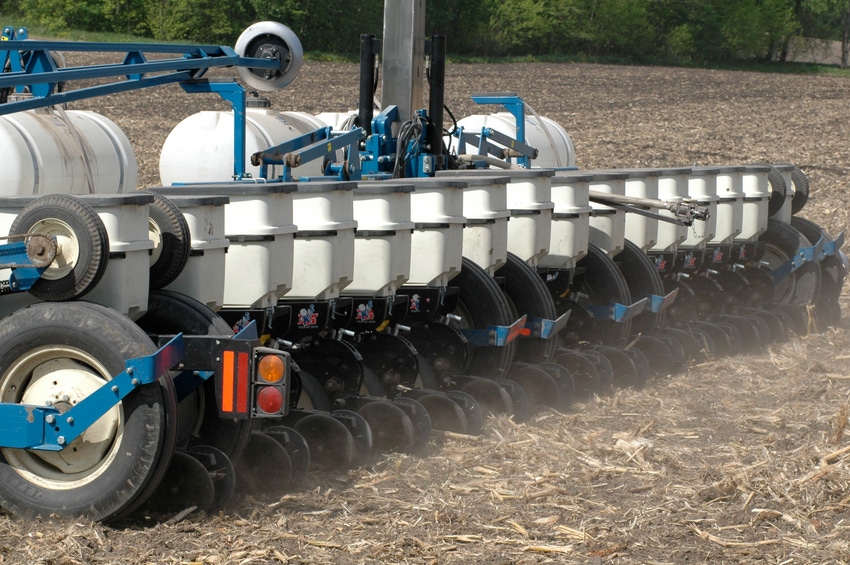April 24, 2018

Source: Iowa State University Extension
With delayed spring weather and low or uncertain grain prices, farmers and crop consultants are asking questions about starter fertilizer for corn this spring. The placement of small amounts of plant nutrients in bands offset to the side and below the seed row or in the seed furrow increases the concentration of nutrients near seedling roots. Common starter fertilizers have nitrogen (N), phosphorus (P), and potassium (K) and sometimes sulfur (S) or micronutrients. Research in Iowa and the north central region has shown that early plant growth increases from starter fertilizer are common and can be large in corn but are uncommon and small in soybean.
Phosphorus and nitrogen are the key nutrients for starter application
The early growth responses to starter fertilizer usually are more frequent in low-testing soils or when conditions are colder than usual. With cold soil, root growth is slowed, the capacity to absorb nutrients is reduced, and the diffusion of nutrients through soil towards the root surface is slowed. These effects are more likely to happen with reduced tillage and high residue cover because the residue keeps soils cooler and wetter for a longer time compared with soils with little cover. However, starter may also help with late planting even if soils are warm. Wisconsin research showed that starter P application was likely to increase yield and reduce grain moisture with very late planting and full-season hybrids. Iowa results were not as consistent, probably because the research did not include many years with late planting dates, and many of the Wisconsin research sites were farther north.
Phosphorus is less mobile in soil than K, and much less than mineral N forms (especially nitrate), thus the P concentration in the soil solution near roots at a particular time can be low. Also, P is very critical for plants during very early growth, and an early P deficiency seldom can be fully corrected after crop emergence. Therefore, it is not surprising that early-season corn growth responses to starter mixtures often is explained by P, sometimes even in soils with optimum soil-test P levels. Starter K seldom increases corn early growth, except with less than optimum soil-test K. In corn, early growth responses to starter N occur less often than for P, and occur mainly when the primary N rate is not applied pre-plant in spring, with no-tillage and in continuous corn. Recent research with starter N applied to the sides and below corn seeds after a cereal rye cover crop showed inconsistent results.
Expectations of yield response to starter application
The effects of starter fertilizer on corn grain yield aren’t as consistent as effects on early growth. Yield responses to starter are more likely in northern Iowa. When the recommended pre-plant P rate is broadcast, yield responses to starter are more likely with cool, wet soils and reduced tillage since high residue cover keeps soils cooler and wetter in spring. However, a yield response to starter P is seldom observed when the two-year P rate for the corn-soybean rotation is broadcast before corn. A response to starter N is unlikely in corn after soybean when the primary N rate is applied pre-plant in spring and when N solutions are used as herbicide carriers. Starter is a good way for applying micronutrients, but extensive research has shown no corn or soybean response to micronutrients except for occasional corn responses to zinc and inconsistent soybean response to iron in highly calcareous soils (with pH greater than about 7.2 or 7.3). ISU Extension and Outreach publication PM 1688 (A General Guide for Crop Nutrient and Limestone Recommendations in Iowa) suggests starter applications for corn under conditions of poor soil drainage, cool soil, crop residues on the soil surface, or late planting dates with full season hybrids .
Be careful with high starter rates with in-furrow application
The rates of starter N and K applied in the seed furrow can’t be too high because salt can damage seedlings. The traditional rule of thumb for in-furrow starter application is to apply less than 10 or 12 lb of N plus K2O/acre, mainly with fertilizers containing ammonium, potash, potassium chloride (KCl), or potassium nitrate. Application to the furrow of urea, ammonium sulfate, and either ammonium or potassium thiosulfate is not recommended. South Dakota State University developed a tool that helps make decisions for in-furrow starter application (Seed-placed Fertilizer Decision Aid). In spite of studies over the years and this tool, no research can fully answer the question of how "safe" higher in-furrow starter rates can be because of several unpredictable factors. Definitely, higher in-furrow rates are not recommended when the soil is dry and lower than normal rainfall is forecast.
In summary, when is a corn yield response to starter fertilizer likely?
1.With lower than recommended P and K broadcast application rates
2.Without primary N application before planting
3.Cooler than normal soil temperatures
4.No-till with high residue cover with low pre-plant application rates
5.Continuous corn, especially in no-till with low or no pre-plant application rates
6.Northern Iowa soils with moderate to poor drainage
7.Late planting dates
You May Also Like




